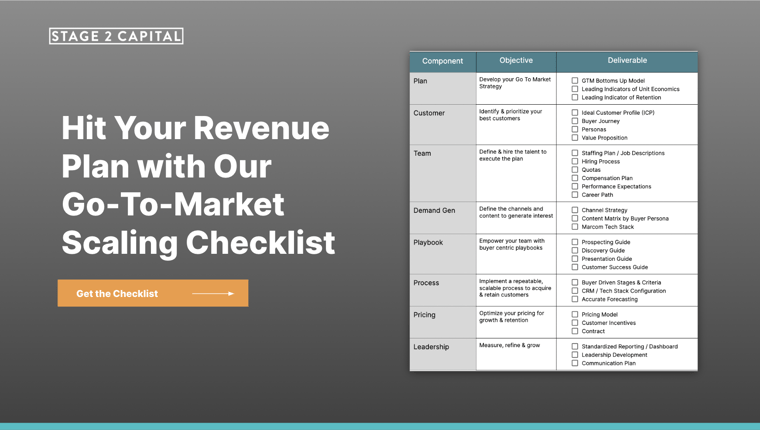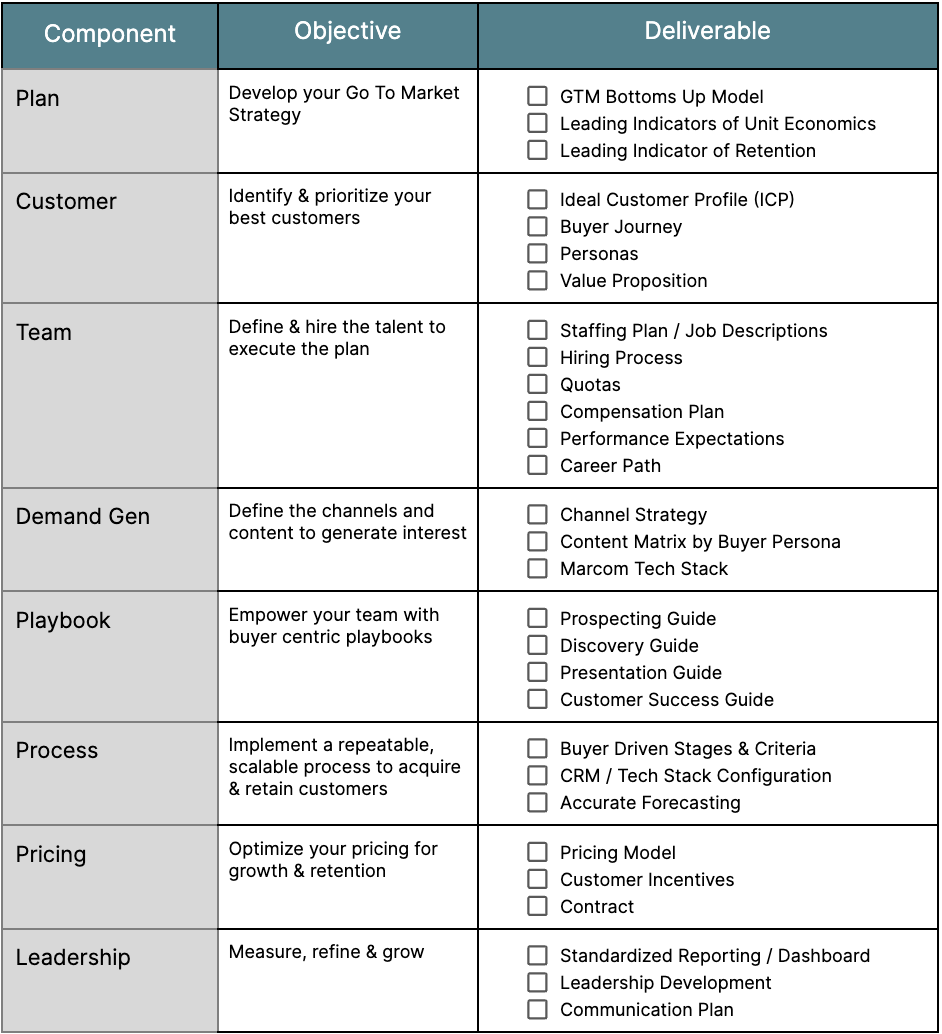Skip ahead and get the Go-To-Market Scaling Checklist here
When companies are scaling their go-to-market (GTM) motion, they often underestimate the components that are needed to successfully execute the strategy. I’ve heard everything from “the team just needs training” to “we just need qualified leads” to “we need to change the comp plan.” The reality is that it’s not one thing, but a combination of things, that creates an effective GTM system.
In my last blog post, I talked about the importance of building a Bottoms Up Model to develop a realistic plan. Once you have that plan, you need a system to implement and operationalize it. My husband is a builder and it’s a similar process. He relies on the architect to give him the plan, but he has to have a team with an effective system to ensure that the house gets built both on time and with amazing quality. He doesn’t look at the list of components needed and think “As long as they have electricity, who needs plumbing?”.
The same reasoning applies to building your GTM system. You can’t pick and choose which components you want — you need all the components to ensure you can deliver your plan. For example, it’s hard to define your playbook or demand generation strategy if you haven’t defined your customer and buyer journey. It’s hard to hire the right profile of a salesperson if you haven’t modeled a plan and also defined your customer to inform the level of experience you need.
I developed this checklist when I was consulting to help early stage founders understand what it takes to hit the revenue plan. Think of your GTM Scaling Checklist as the blueprint that drives the outcome of your Bottoms Up Model (revenue). Your inputs are the number of people and prospects according to your plan. From there, both your sales team and the customer need process and support to generate the outputs, which are the activities that lead to a revenue forecast that converts to real revenue.
What’s included in a Go-To-Market Scaling Checklist?
The system we use at Stage 2 Capital helps companies develop the components they need to fully operationalize go-to-market, along with the deliverables needed for each component.
- Plan - This is your strategy to deliver your revenue target. Your Bottoms Up Model is the key deliverable of this component, and also drives your Leading Indicators of Unit Economics.
- Customer - The center of every GTM system is the customer since they impact everything from marketing to product. Focusing on the ideal customer profile (ICP), their relevant colleagues that might be included in the process, and the journey they all take is critical to align all GTM and product functions.
- Team - Who is responsible for delivering this plan? When do you need to hire them? How much will they make? What is expected of them to hit their quota? Your Bottoms Up Model should answer most of these questions, but it’s equally important to provide your team with the resources they need to understand what you expect, what they will make, and what opportunities they have to grow in your organization.
- Demand Generation - How are you going to generate interest with the customer profile you’ve identified? The days of hiring a few salespeople and telling them to hit the phones are over. Are you relying on inbound leads, an outbound/ABM strategy, product led growth (PLG) or a combination of these? Clarifying the channels you are testing, the content strategy you will use by persona and the technology you need to operate and measure is critical to hitting your GTM plan.
- Playbook - Customers are interested in talking with you! What now? Defining the playbooks for prospecting, discovery, presentation and customer success will help you quickly identify what is working and what needs to be improved when there is consistency in the process. How will your team learn to use these? You need an enablement plan for not just onboarding but also ongoing training.
- Process - How are you managing the customer pipeline to optimize your sales cycle and forecast accurately? Buyer driven stages / criteria and the right technology should drive both of these.
- Pricing - Packaging and pricing your product to optimize for growth AND retention is key to scaling. You want a plan that works for your current stage, as well as standardized contracts and incentives, in order to keep your CAC and payback period in line.
- Leadership - What’s a system without a leader? Hiring the right sales leader and investing in their ability to measure results, invest in themselves, and communicate effectively will return results in spades.
Go-To-Market Scaling Checklist
How do I assess my GTM system?
This checklist helps you evaluate your current system and identify areas for improvement.
- If you are hitting your revenue plan, you still want to use the checklist to identify any missing deliverables that could impact you in the future, or deliverables that need to be updated or refreshed. Just because you have it doesn’t mean that it’s the right thing for your business now. You have to keep evolving. We recommend reviewing the GTM checklist quarterly to identify opportunities for improvement.
- If you are missing your plan, using this checklist can help you identify gaps that can improve your system and your results.
I also recommend having a third party that has GTM experience assess your system. It’s hard to be objective when it’s your baby, so having someone with fresh eyes to provide feedback on opportunities to improve is super valuable.
The great news is that evaluating your system now will help you make improvements that will really pay off in the next year. Stay tuned for our GTM playbook coming soon, and you can download your own version of our Go-To-Market Scaling Checklist here!


